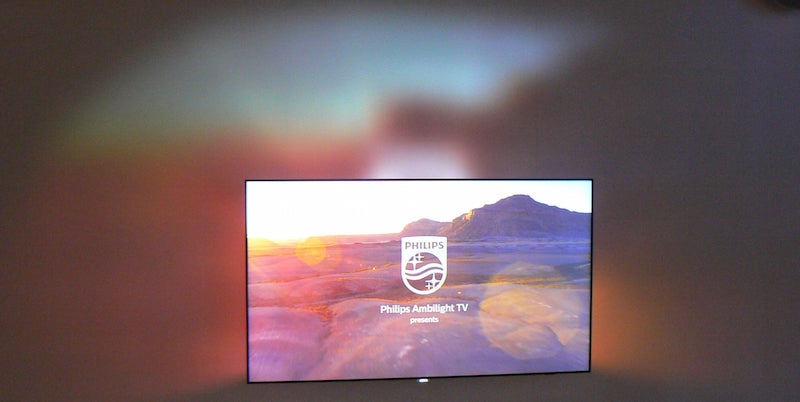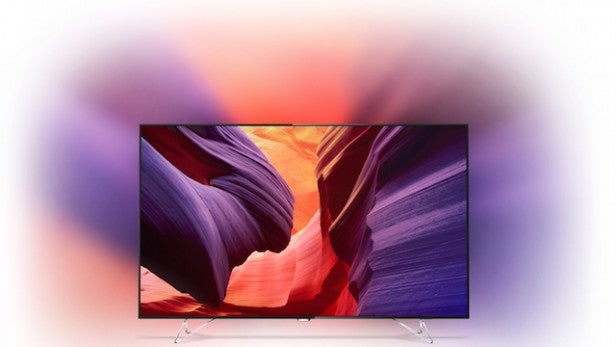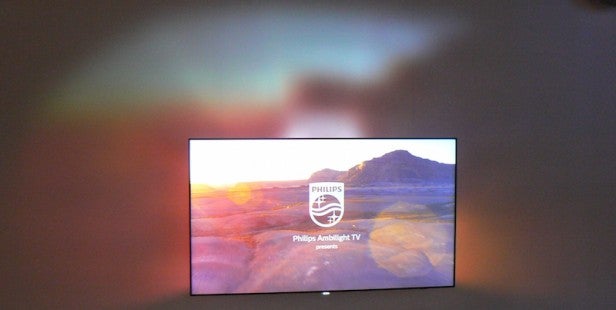Philips 65PUS8901 Ambilux TV Review
Philips 65PUS8901 Ambilux TV
Hands on: Philips' latest, maddest but also possibly greatest glow-in-the-dark TV

Verdict
Philips 65PUS8901 Ambilux TV first look
At an IFA 2015 show rather short on spectacular bits of AV tech, Philips’ first Ambilux TV shines out like a beacon in the night. Literally.
The concept behind this new TV – which is a product going on sale, not just a prototype – is that it extends the scope of Philips’ Ambilight technology by using an array of projectors built into the TV’s rear. These projectors cast onto your wall a ghostly copy of the image being shown on the screen.
Ambilight has been getting ever more accurate with the tone and localisation of its colour-matching effects over the past few years, so we guess in some ways the new Ambilux system – which will be available on the 65-inch 4K 65PUS8901 – is the logical extension of that process. But you still have to admire the extra miles Philips has gone to achieve the Ambilux effect.
Fittting no less than nine DLP LED projectors in an arc formation into the rear of a slim TV and then getting all those projectors aligned to stitch together a seamless, non-overlapping representation of the image on the TV screen can hardly have been child’s play. Yet on the evidence we’ve seen during IFA demos the results are remarkably impressive – once you get used to them.
SEE ALSO: Panasonic TX-65CZ950 4K OLED TV first look
When I first found myself goggling at the 65PUS8901 in all its Ambilux glory, the feature struck me as being just too much. Unlike normal Ambilight technology, it distracted me from what I was watching. This was particularly the case when the projected effect reproduced a strong element of the image on the TV screen – a person’s face, perhaps, or a brightly coloured car. Initially my eyes couldn’t help but be drawn away from the TV screen towards what the Ambilux effect was doing.
Also a bit disturbing initially is just how large the Ambilux effect is. You can adjust the size of the light show’s ‘splay’, but even in its smallest mode it covers a much bigger area of wall around the screen than any ordinary Ambilight system.
Over time, though, it was interesting to see how our brains started to adjust to the effect. The more we got used to it being around (literally), the more content our brains became to letting the Ambilux effect remain in our peripheral vision. And the more that happened, the more effective it became.
Plus, crucially, Philips provides you with a good selection of adjustment options beyond the resizing, to help you tweak Ambilux’s impact.
For instance, there are six presets for the feature, ranging from Relax, which produces a very soft and vague echo of the image you’re watching, to Extreme, which sharpens the Ambilux image up and responds very quickly to any motion that might be in the source image. The default Standard mode picks a mid point between Relax and Extreme, while a Dome mode warps the projected image into a dome shape to reduce the similarity between the Ambilux image and the picture you’re watching.
There’s also a fun Cube mode which presents the Ambilux images as large pixels – this one’s surprisingly effective when gaming – and a Tunnel model which squares the edges of the image up and slightly blurs them at their extremes to boost the impact of, say, a driving game.
SEE ALSO: LG 65EF9500 flat OLED TV first look
The 65PUS8901 will also let you adjust the brightness of the Ambilux effect, and allows you to tell the TV what colour your wall is so that it can adjust Ambilux’s colour output accordingly. So much fun have Philips’ designers apparently been having with Ambilux, in fact, that the set even carries a suite of Ambilux music settings, where the projectors fire out fun and funky effects to accompany a concert video or music source.
There are, though, a few issues with, and limitations to, the Ambilux system. First, to get the optimum effect you’ll need to position the TV 20cm from your wall, give or take a centimetre or two. Because of this Philips has had to design an optional mount for it that holds it 20cm away from the wall it’s mounted on!
We suspect, too, that the 65PUS8901 will have to burn more power than a typical LCD TV to keep those nine projectors juiced up. The TV hasn’t completed its official testing where power consumption is concerned, but Philips seemed surprisingly confident under questioning that the 8900 TV could secure a very respectable A grade. We’ll have to wait and see.
You also have to wonder how much the TV might cost given the presence of those projectors. Philips wasn’t willing to discuss pricing on the set yet, which isn’t necessarily ominous, but still leaves us none the wiser.
By far the biggest issue with Ambilux for many UK households, though, is the fact that it doesn’t really work if the TV is placed in the corner of a room. It really needs to be placed in front of a flat wall. Even if you love the idea of Ambilux, you may not have the right-shaped living room.
Early Verdict
The 65PUS8901’s 4K picture – the proper one produced by its actual screen, not by the rear projectors – looks seriously promising thanks to a combination of brightness, bold colour saturations, extreme sharpness and potentially strong contrast. Combined with the striking Ambilux tech, this is definitely a set we’re looking forward to spending more time with when it launches in December.
How we test televisions
We test every TV we review thoroughly over an extended period of time. We use industry standard tests to compare features properly. We’ll always tell you what we find. We never, ever, accept money to review a product.

